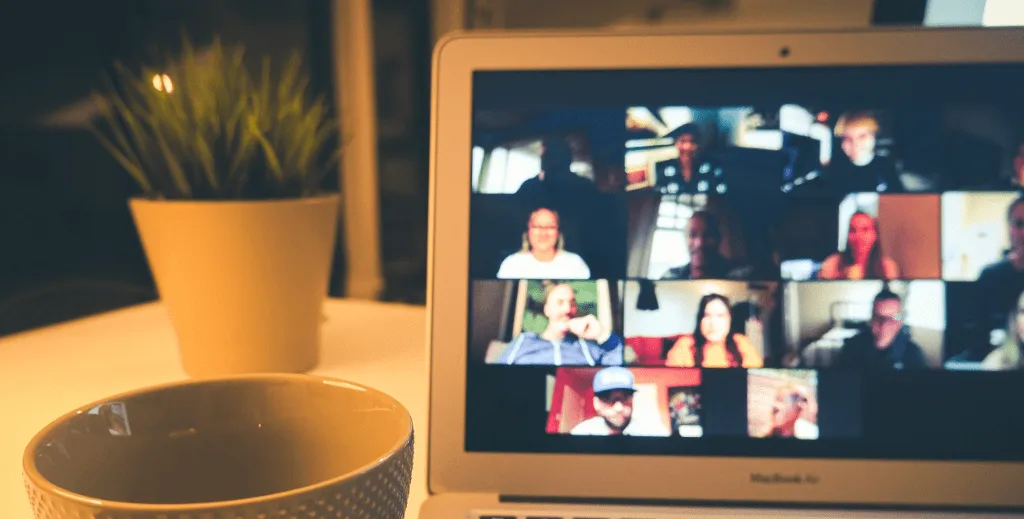The Four Biggest Causes of Zoom Fatigue (and How to Beat Them!)

The world of work is going digital, and a big part of that is the meteoric rise in video calls. Whether for one-on-one meetings, large video conferences, or a chat with your gran, we are turning to video more than ever to keep us all in the loop.
Interestingly, video calls are now becoming standard tools, often with the expectation that you’ll have to pull out your laptop for many of the tasks that were once done over the phone. For the most part, that’s fantastic! Video calls can, among other things:
-
•
Reduce meeting costs
-
•
Increase collaboration
-
•
Boost team productivity
-
•
Save time
-
•
Retain personal connections between remote workers
Unfortunately, while video calls are an excellent tool for any business, they also have drawbacks, such as “Zoom fatigue.” These side effects of video calling can have a severe impact on your employees and your business, so let’s take a look at the four main reasons why this happens and some simple solutions to combat it.
How To Recognize Zoom Fatigue
Zoom fatigue isn’t diagnosable in the same way as many other things, and there is some debate over what exactly it even means. However, it is very much real, and there are a few common ways to recognize it in yourself or your colleagues.
In terms of physical symptoms of video meeting fatigue, you might find yourself with:
-
•
Headaches
-
•
Migraines
-
•
Eye irritation and pain
-
•
Blurred or double vision
-
•
Excessive tearing
-
•
Excessive blinking
This is in addition to a whole host of mental and emotional symptoms such as:
-
•
Decreased attention
-
•
Sleep problems
-
•
Decreased mental capacity
-
•
Decreased physical capacity
-
•
Emotional exhaustion
-
•
Reduced motivation
-
•
A feeling of “tech invasion”
All of these possible symptoms of video meeting fatigue will cause serious short and long-term problems for team members, both in their work and personal lives.
Zoom Fatigue is Part of a Wider Problem

Zoom fatigue is actually contributing to the broader problem of burnout. Burnout is a term that was first coined in the 1970s to describe what happens to “helping” professionals (such as doctors and nurses) when they face sustained and intense stress.
Nowadays, it is far broader, with people in basically every industry facing some level of burnout when working too much, too hard, or in the wrong way. The key symptoms of burnout at any workplace are:
-
•
Exhaustion
People suffering from burnout will often feel mentally and physically drained, unable to cope with the problems they face, and lack the energy to do anything about it.
-
•
Physical symptoms
Pain and stomach or bowel problems.
-
•
Alienation from work-related activities
Burnout can cause people to become increasingly frustrated and stressed out by the work, leading to them lashing out at tasks that they may have once enjoyed and even their colleagues. At the same time, they may become increasingly closed off and numb to their work.
-
•
Reduced Performance
Tasks at work and in the home can seriously suffer from burnout. This can be down to the person having feelings of negativity towards the task and lacking concentration and creativity.
Looking at the symptoms, it’s clear to see how Zoom fatigue and burnout are so intertwined, but now it’s time to explore some of the reasons this fatigue exists and, more importantly, the solutions to tackle them.
Too Much Eye Contact and Disproportionate Faces
If you sat in a conference room and your colleague sat opposite, just staring into your eyes, you probably wouldn’t be pleased. You’d probably leave that meeting, bolt the door, call security and seriously wonder whether your boss hired Patrick Bateman.
Well, that’s what you have to put up with every time you hop on a video call. In a regular meeting, you would be looking about, changing focus, or glancing at your notes (or maybe the clock). On a video call, it’s nothing but faces, meaning we are engaging in an unnatural amount of eye contact.
To make matters worse, all staring faces are just a little bit too big, especially if you’re using a large external monitor. The floating heads of a video call are so large that they appear as if they are well within your personal space, close enough that they could easily touch you.
Our minds interpret this as if it were a real-life scenario, where a face that close would mean one of two things: courtship or conflict. Either way, it involves a level of intensity that we simply can’t sustain for long.
Solution:
This is where shared documents and non-video collaborative workspaces can be beneficial. If you feel as if you have spent too long staring into the eyes of your colleague, and Zoom fatigue is setting in, then switch your work to a collaborative Note. This way, you can still work together but not have the direct eye contact that can be so taxing.
What’s more, if a video meeting is required, consider keeping the call out of fullscreen (and maybe even downsized a little) so that faces don’t feel so close. This should help reduce the level of intensity you would otherwise have from people being all up in your face.
Seeing Yourself in Real-Time Leads to Meeting Fatigue

Walking around the real world, you’ll undoubtedly see yourself sometimes – in the bathroom mirror or a glimpse of a reflection in a storefront window. However, what never happens is someone holding a mirror up to your face whenever you say anything, make decisions, give feedback, or even listen to someone else talk.
In video calls, this is precisely what is happening. When you join the meeting, you see yourself in a little box in the corner of the screen, mirroring your every move. Unfortunately, studies have shown that when you see a reflection of yourself, you tend to be more self-critical.
With people spending many hours every day in meetings, always looking at themselves, it’s no surprise that their stress levels are spiking, and Zoom fatigue is setting in.
Solution:
There is often no need to have your video reflected back at you, so turn off the “self-view” mode if your platform allows. If you’re using a service that doesn’t yet give you the option to hide, then explore other communication channels.
Try swapping out some of your planned video calls with a phone call instead, or even scrapping synced meetings entirely and getting things done over email or voice messages.
Video Calls Keep Us Stuck in Our Chairs
If you’re having a meeting via the phone or even in person, you have the opportunity to get up and move while you talk. Whether it’s pacing the room or flailing our arms about to make a point, we move our bodies to communicate.
Video calls, on the other hand, which rely on tightly-framed webcams and poor-quality microphones, keep us rooted to the spot. There is no freedom to leave your seat, let alone pace the room while you try to explain your point, and this limitation is simply unnatural.
Solution:
Take the time to think about the room in which you are based and the hardware you’re using. If you can get an external camera and a Bluetooth keyboard that allows you to wander the room while on a call, then this will help combat Zoom fatigue.
If the video meeting is particularly long, then don’t be afraid to switch off your camera and stretch your legs – just make sure that it’s established practice in your team.
Video Calls Lead to High Cognitive Load
An incredible amount of communication between people happens without anyone saying a word. From subtle gestures to subconscious expressions, non-verbal communication is a natural part of our conversations in person. So natural that we don’t have to think about it at all.
The opposite is true when you’re on a video call. All nuance and subtlety are lost. To communicate what would typically be second nature. You either have to verbalize your feelings or resort to exaggerated actions, like the giant wave and full-frame thumbs-up that many use.
All of this uses brainpower that would otherwise be free to focus on more interesting things. Simply thinking about how to communicate what would normally be non-verbal leads to a higher cognitive load on video calls and thus Zoom fatigue.
Solution:
To reduce how mentally taxing it can be to try to watch for and reciprocate gestures over video, simply take a break from the camera. During longer meetings, have a set amount of time that you switch to audio-only mode. Turn off your camera and stop giving everyone that thumbs-up.
Other Causes of Video Meeting Fatigue
Beyond these four key reasons for Zoom fatigue, there are numerous other smaller factors that stack up to cause video meetings to be tiring. A few others to consider are:
Homes are Private Places (and that Stresses Us Out)

If you’re on video calls from your home, it’s inevitable that parts of your personal life will find their way into your background. Whether it’s your favorite movie poster, that old family photo, or something much more private, when our homes are exposed to the world, we can get embarrassed and stressed, leading to fatigue.
If you’re a business owner with remote employees, you can limit this worry by issuing several virtual backgrounds that your team can use when they don’t feel comfortable. Make these fun and on-brand, and they can end up adding a nice twist to in-company meetings and an added touch to customer-facing calls.
Unannounced Calls Exacerbate Meeting Fatigue
As we’ve established, the side effects of video calling can be severe, and they are further exacerbated when the calls pop up unannounced. If you’re working in an office and a meeting is suddenly called, no problem, you’re already there.
A video conference for home workers, however, is a different beast entirely. Most people get ready before heading out for their workday, but they may be more relaxed at home in their attire, hair, and the state of their desk. If there is suddenly a video call, it can cause full-blown panic.
The simple solution to this one is to always plan ahead!
Many Tabs Mean More Fatigue
It can be tempting to flick between tabs while you’re on a video call (especially if the speaker isn’t particularly engaging), but multitasking increases fatigue. Video calls are mentally taxing as it is, but if you start trying to get other things done at the same time, you’re setting yourself up for failure.
If you’re on a video call, try to close other tabs or at least open the call in a new window. Having all your work tools in a single app can help with this since you won’t be tempted to switch programs while on a call.
A Quick Look at Causes of Zoom Fatigue
To recap, Zoom fatigue can cause a whole range of physical, emotional, and mental symptoms and can quickly spill over into full-blown burnout. The four primary reasons that video meeting fatigue happens are:
-
Overly-intense eye contact
-
A little too much self-reflection (well, looking at yourself)
-
Restricted mobility (as compared with phones and in-person meetings)
-
The high cognitive load of video calls
However, there are solutions! From turning off your camera to closing tabs and creating fun backgrounds, there are plenty of small changes you can make to have a big impact on video meeting fatigue.
It’s important to note that many of the symptoms of video meeting fatigue and burnout more generally are closely aligned with serious conditions such as depression. Make sure that if you see team members exhibiting any symptoms, not ascribe it to Zoom fatigue too readily. There should be policies in place to take care of the physical and mental wellbeing of all remote employees.
For more tips and tricks to stay healthy and happy while working remotely, stay tuned into the Spike blog. If you or your team have developed any of your own tools to fight fatigue, why not let us know by tweeting us @SpikeNowHQ.




